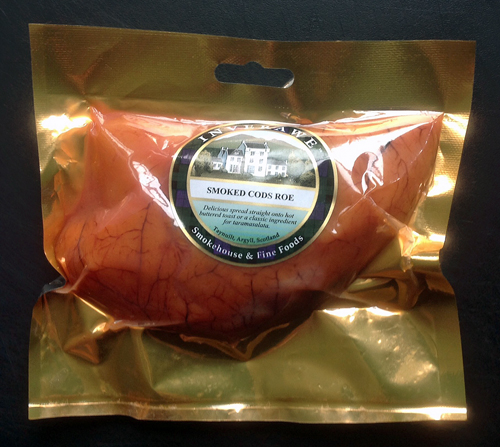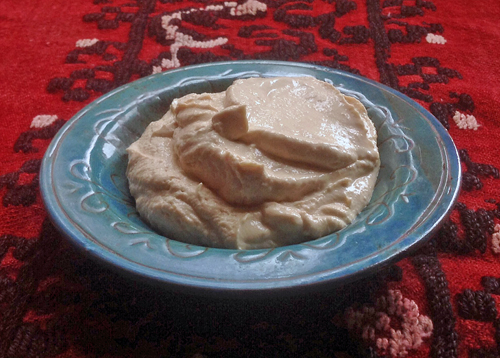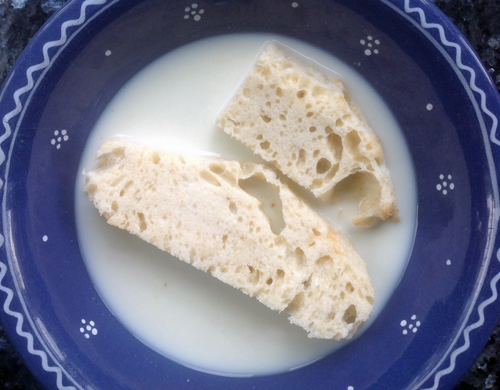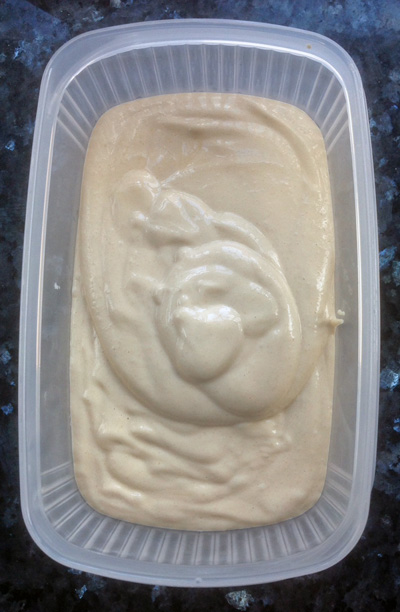One of the foods I associate most with Greek Lent is taramasalata, a cod’s roe dip. Taramasalata traditionally features on the table for “Clean Monday” (Καθαρά Δευτέρα, the Monday before Lent) along with the flat, sesame studded lagana bread. But, it has become one of those mezze (“little nibbles”) that is popular at any time, not just for Lent.
It’s always a treat when I find smoked cod’s roe (tarama), in the market. When made into a dip called taramasalata, it is transformed into a luscious thick pink purée of roe whipped up with olive oil and lemon juice, traditionally thickened with either bread or mashed potato. Taramasalata is not only traditional in Greece, but also in Turkey, other places in the Middle East and I’ve even seen recipes for Bulgarian taramasalata.
I’ve modified a recipe set out in Claudia Roden’s The New Book of Middle Eastern Food, joining in the challenge set by The Cookbook Guru, the blogging book club that is testing recipes from Roden’s book this month. If you want a gluten free version, simply substitute the soaked bread with with an equal amount of floury mashed potato (approximately 1 medium sized potato), preferably put through a potato ricer. The potato version will be slightly thicker and smoother when blended.
Taramasalata
In her recipe, Claudia Roden advocates using half sunflower or light vegetable oil in place of half of the olive oil. She claims it allows the fishy flavor to come through. However, this seems almost sacrilegious to me, substituting vegetable oil for olive oil. I would also rather mute the overt fishiness, so I’ve used 100% olive oil. Don’t get me wrong, I like fish, but prefer it as a subtle flavor rather than an overwhelming one. In addition, I’ve halved her recipe, saving some of the roe to produce a gluten free batch with potato.
Makes about 1 to 1-1/2 cups
- 1/4 lb. (4 oz.) smoked cod’s roe
- 1-1/2 slices day-old white bread (from a good country white bread), crusts removed
- Juice from 1/2 lemon (or more to taste)
- 1/4 cup extra virgin olive oil
Slice the bread thickly and soak it in either water or milk. Roden, like the traditional purists, uses water.
Meanwhile, skin the cod roe sack and remove the mass of eggs. Squeeze the liquid from the bread. Place the crumbled bread, the roe, and the lemon juice into a food processor. While the blender is turned on, gradually pour in the olive oil in a steady stream as you would do when making a mayonnaise. If you like a strong fishy flavor, use 2 Tablespoons sunflower oil and 2 Tablespoons olive oil in the recipe above in place of the 1/4 cup olive oil. Run the processor on high for a few minutes until the mixture begins to thicken.
It should become a smooth, creamy peachy-pink paste. The color is lighter than the store bought taramasalata because it does not use food coloring to enhance the pink shade. Pour/scrape out, cover and place in the refrigerator. The taramasalata will appear a bit thin initially, but it will become firmer when it chills. It will keep refrigerated for about a week.
Notes & Evaluation:
This is a simple, traditional recipe that is featured in any number of cookbooks on Greek, Turkish or Middle Eastern cuisine – as are many of the other recipes listed in Roden’s chapter on appetisers (mezze). In fact, in the introduction to the book, Roden comments on the commonality of recipes throughout a wide area around the Middle East and the Mediterranean. Differences, she indicates, can be found at the regional scale right down to the household level. So, it follows that among the many taramasalata recipes available, there are variations – in the proportion of bread v.s. roe, the choice of bread or potato or a combination of the two, minor additions to the ingredient list. Some Greek recipes for taramasalata insist that grated onion be added; several Turkish recipes similarly add garlic. Roden’s version follows along the same lines as the basic tried-and-true recipe, except perhaps for her suggestion of using half vegetable oil, half olive oil. I think she has a good balance between the roe and bread – not too much of the latter – and is wise in not adding onion or garlic which compete – and, in my opinion, conflict – with the flavor of the smoked roe. All in all, you can’t go wrong with Roden’s recipe, but follow her sage advice she also sets out in her introduction – trust your own tastes and make adjustments accordingly.





This looks very tasty. I have never made it with the actual roe , ie the one with skin on, but often find a dark brown/pink paste in Greek delis which I use in excatly the same way as the recipe given above. I wonder how different they are in taste and now am driven to find the actual whole roe in skin on.
LikeLike
When we lived in the US, I only ever found cod’s roe in Greek delis – doled out in little containers. It wasn’t until we moved to the UK that I found this wonderful Scottish smoked cod’s roe (as well as a number of other smoked fishy delicacies). I think it is a stronger flavour, but can’t say if it is because of the skin still on, or the fact that it comes from Scottish cod and was smoked locally. A kind of fishy terroir!
LikeLike
I love the fishiness of taramasalata, but confess to having never made it. No excuse, just never bothered. I’m going to keep my eye out for cod roe, you’ve made it sound so simple. Yum!
LikeLike
It is incredibly easy! Look in Greek delis for the stuff.
LikeLike
Yum, this looks amazing & I love taramasalata. Thank you for your contribution for the cookbook guru and your thoughts on the book itself. I hope you find inspiration on everyone else’s contributions 🙂
LikeLike
I love Roden’s book, though I have her 2000 edition, not the original one. Her extensive introductory chapters are, for me, the real gem of the book – though her cataloging of traditional recipes is incredibly useful (and delicious). Hope to do at least one more for TCG!
LikeLike
I ended up ordering a copy of the book for myself, I can’t wait for it to arrive so I can explore it after hearing such great things. Mum has suggested I can literally read it like a novel :-). She has also challenges me to Turkish delight a la Roden which will be a great challenge 🙂
LikeLike
Loukoum is certainly a challenge!!! In damp, rainy England it is almost impossible to make. Yes, the book is a very good read – the kinds of cookbooks I tend to go back to time after time. You’ll love it!
LikeLike
With the humidity we’ve had here in Brisbane I’m imagining it a challenge here too, but I’m hoping that it will be dry enough to work with comparison to December when it literally melted before our eyes 🙂 fingers crossed for a more successful result
LikeLike
I’ve never had taramasalata, but I’ve eaten cod roe on any number of occasions and usually as a pasta sauce or topping. I’d love to give this a shot, seeing how I love warm flatbreads with a savory schmear on them.
LikeLike
If you like cod’s roe, you’ll love taramasalata. Great on flatbreads, but also with veggies – raw carrot sticks, celery, baby tomatoes, etc. Enjoy!
LikeLike
Reblogged this on The Cookbook Guru and commented:
We have a beautiful contribution here to The Cookbook Guru from our newest member: My Kitchen Witch. Read all about the traditions behind this delicious recipe for Tarama and also get a beautiful assessment of the recipe too.
Leah
LikeLike
Yum, yum, yum!! I LOVE the homemade variety, lucky you!
LikeLike
Homemade is so much better! I would have thought you could find smoked cod’s roe in Italy. Puzzling… perhaps substitute bottarga which could be anything from tuna to mullet roe – popular in Sicily and Sardinia. Apparently, the original taramasalata was made with mullet roe.
LikeLike
Ohhh … I’m so envious now! I tried and fell in love with taramasalata in england… But in Italy i can’t find nothing… No ready made one… No cod’s roe …:(
LikeLike
Bottarga would be a good choice here. According to Claudia Roden, grey mullet roe was the original roe used in making taramasalata. Either that, or visit Greece…😄
LikeLike
It’s never even occurred to me to make tarama – I bet it tastes totally different to the mass produced efforts that i admit I’m not fond of.
LikeLike
Homemade is better…the benefits of being able to modify the ingredients to suit your individual tastes. It is, however, creamy, salty & fishy, so you have to like these tastes and textures to begin with. Give it a try. You may still not be fond of taramasalata, but that’s okay. I personally won’t touch anything made with cauliflower. We all have our own tastes!
LikeLike
At my previous home, my next door neighbor was Greek and always invited us to celebrate their holidays. This recipe was one she served and that my husband and I enjoyed. Thank you for bringing back nice memories of friendships and good food. 🙂
LikeLike
It always great to have memories like that, especially if it involves food!
LikeLike
[…] Tarama by The Kitchen Witch […]
LikeLike
Hello! I just wanted to let you know that your lovely tarama recipe has been featured over at BritMums in June’s Food Round up…
http://bit.ly/SJgnS7 Emma 🙂
LikeLike
Thank you!
LikeLike